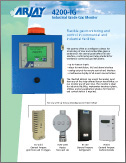 Why your gas sensor placement is missing the mark (and how to fix it!)
Why your gas sensor placement is missing the mark (and how to fix it!)
August 1, 2014 REDWIRE is news you can use from leading suppliers. Powered by FRASERS.
Posted by Arjay Engineering Ltd.
Arjay Engineering has been designing and manufacturing process and environmental controls for over 30 years. Our main fa... Read more
Subscribe
Free REDWIRE e-newsletter

The proper location of a gas detector can mean the difference between safety and danger when harmful gases are leaked within a confined area.
Factors such as the source and density of gas, area layout and function and detector accessibility for routine servicing and testing, are some of the considerations to bear in mind prior to selecting an appropriate gas detector supplier or manufacturer. Depending on individual gas properties, the placement of the gas detector will change.
Looking for advice on the most effective placement of your gas detector? Well, look no further.
Mixed in with a little chemistry 101 on five common gas types, get on target with some gas detector installation pointers, which varies based on the location, area and building type.
Chilled chambers
Places such as ice arenas, food and drink packaging plants and chiller rooms are at risk for ammonia exposure when a pipe, tank or valve leak takes place.
Designated as NH3, ammonia is lighter than oxygen meaning that it will rise to the upper limits of a room or space.
Detector installation for this type of gas is best placed as near to the ceiling as possible on a wall, pillar or column of an area. Best practice suggests installing the detector close to the source of a possible leak, such as near the gas pipe, tank or valve to avert gas exposure.
Messy areas
Methane (CH4) is the by-product from areas such as sewage treatment plants, wastewater facilities and landfill zones. Similar to ammonia, methane is lighter than air, thereby naturally gravitating upwards to ceiling height.
Methane can become explosive when saturated and trapped in ceiling pockets, so placement of a detector for this type of gas certainly belongs as close to the ceiling as possible.
Parking and Repair Garages or Sheds
While moderate levels of carbon monoxide (CO) and nitrogen dioxide (NO2) in these places is expected because of the presence of vehicle exhaust, the goal is to install the detector as a gauge ensuring that CO and NO2 concentration levels are kept at bay.
CO and air carry similar densities: once there is air movement, the saturation of CO will disperse within the air. Make sure that vehicles, repair equipment and vehicle exhaust are not in direct contact with the detector in order to maintain proper monitoring.
However, NO2 is heavier than air and has the ability to reach dangerous levels of toxicity much faster than CO. While low concentrations of this by-product from diesel exhaust are acceptable, repair pits that have higher exposure to NO2 should install individual detectors to measure levels.
Experts recommend one detector per every 5,000 square feet of open space, and two or more detectors where garages have an irregular shape or hidden nooks where CO and NO2 can possibly accumulate.
Recommendations for placement of CO and NO2 detectors are between four to six feet, which correspond to the suggested breathing zone. Always check your local and municipal by-laws on specific breathing zone guidelines for commercial garages.
Hot Spots
Engines and heaters emit propane (C3H8), a gas that is heavier than air and collects in the direction of the floor; this location has a higher incidence of rising to flammable levels.
Detector placement is recommended at 12” to 18” on the wall, pillar or column above grade to the floor and clear from any obstruction to ensure proper monitoring.
On target, on time and on budget
Arjay Engineering Ltd. hits the bulls-eye for our clients’ gas detector needs with our skillfully crafted and custom design engineering services.
With more than three decades in the environmental control panel assembly business, we provide expert solutions for industries including automotive, food and beverage, petrochemical and utilities.
Let us help you find the sweet spot for your next gas detector. We’re on location in Toronto, Vancouver and Beijing and ready to position you and your business ahead of the competition. Contact us for more information today.
Share
Posted by Arjay Engineering Ltd.
Arjay Engineering has been designing and manufacturing process and environmental controls for over 30 years. Our main fa... Read more